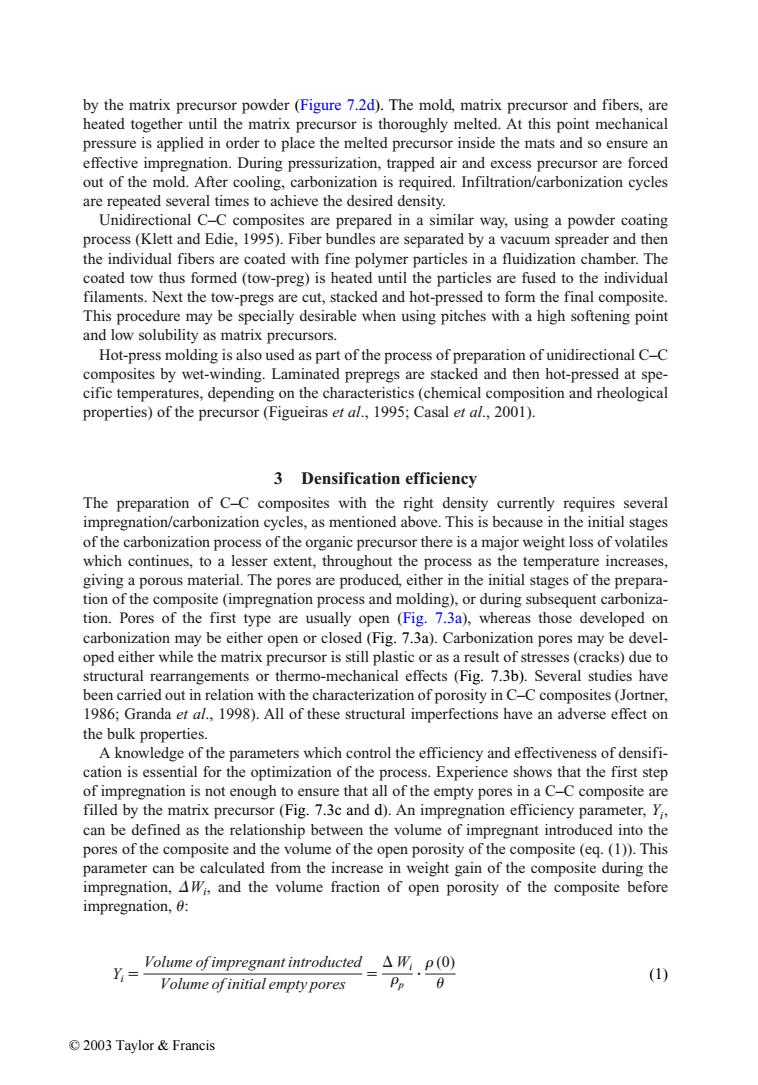正在加载图片...

by the matrix precursor powder (Figure 7.2d).The mold,matrix precursor and fibers,are heated together until the matrix precursor is thoroughly melted.At this point mechanical pressure is applied in order to place the melted precursor inside the mats and so ensure an effective impregnation.During pressurization,trapped air and excess precursor are forced out of the mold.After cooling,carbonization is required.Infiltration/carbonization cycles are repeated several times to achieve the desired density. Unidirectional C-C composites are prepared in a similar way,using a powder coating process(Klett and Edie,1995).Fiber bundles are separated by a vacuum spreader and then the individual fibers are coated with fine polymer particles in a fluidization chamber.The coated tow thus formed (tow-preg)is heated until the particles are fused to the individual filaments.Next the tow-pregs are cut,stacked and hot-pressed to form the final composite. This procedure may be specially desirable when using pitches with a high softening point and low solubility as matrix precursors. Hot-press molding is also used as part of the process of preparation of unidirectional C-C composites by wet-winding.Laminated prepregs are stacked and then hot-pressed at spe- cific temperatures,depending on the characteristics(chemical composition and rheological properties)of the precursor(Figueiras et al.,1995;Casal et al.,2001). 3 Densification efficiency The preparation of C-C composites with the right density currently requires several impregnation/carbonization cycles,as mentioned above.This is because in the initial stages of the carbonization process of the organic precursor there is a major weight loss of volatiles which continues,to a lesser extent,throughout the process as the temperature increases, giving a porous material.The pores are produced,either in the initial stages of the prepara- tion of the composite (impregnation process and molding),or during subsequent carboniza- tion.Pores of the first type are usually open (Fig.7.3a),whereas those developed on carbonization may be either open or closed(Fig.7.3a).Carbonization pores may be devel- oped either while the matrix precursor is still plastic or as a result of stresses(cracks)due to structural rearrangements or thermo-mechanical effects (Fig.7.3b).Several studies have been carried out in relation with the characterization of porosity in C-C composites (Jortner, 1986;Granda et al.,1998).All of these structural imperfections have an adverse effect on the bulk properties. A knowledge of the parameters which control the efficiency and effectiveness of densifi- cation is essential for the optimization of the process.Experience shows that the first step of impregnation is not enough to ensure that all of the empty pores in a C-C composite are filled by the matrix precursor(Fig.7.3c and d).An impregnation efficiency parameter,Y, can be defined as the relationship between the volume of impregnant introduced into the pores of the composite and the volume of the open porosity of the composite (eq.(1)).This parameter can be calculated from the increase in weight gain of the composite during the impregnation,AWi,and the volume fraction of open porosity of the composite before impregnation,0: Y= Volume ofimpregnant introducted AW p(0) Volume ofinitial empty pores Pp 0 (1) ©2003 Taylor&Francisby the matrix precursor powder (Figure 7.2d). The mold, matrix precursor and fibers, are heated together until the matrix precursor is thoroughly melted. At this point mechanical pressure is applied in order to place the melted precursor inside the mats and so ensure an effective impregnation. During pressurization, trapped air and excess precursor are forced out of the mold. After cooling, carbonization is required. Infiltration/carbonization cycles are repeated several times to achieve the desired density. Unidirectional C–C composites are prepared in a similar way, using a powder coating process (Klett and Edie, 1995). Fiber bundles are separated by a vacuum spreader and then the individual fibers are coated with fine polymer particles in a fluidization chamber. The coated tow thus formed (tow-preg) is heated until the particles are fused to the individual filaments. Next the tow-pregs are cut, stacked and hot-pressed to form the final composite. This procedure may be specially desirable when using pitches with a high softening point and low solubility as matrix precursors. Hot-press molding is also used as part of the process of preparation of unidirectional C–C composites by wet-winding. Laminated prepregs are stacked and then hot-pressed at specific temperatures, depending on the characteristics (chemical composition and rheological properties) of the precursor (Figueiras et al., 1995; Casal et al., 2001). 3 Densification efficiency The preparation of C–C composites with the right density currently requires several impregnation/carbonization cycles, as mentioned above. This is because in the initial stages of the carbonization process of the organic precursor there is a major weight loss of volatiles which continues, to a lesser extent, throughout the process as the temperature increases, giving a porous material. The pores are produced, either in the initial stages of the preparation of the composite (impregnation process and molding), or during subsequent carbonization. Pores of the first type are usually open (Fig. 7.3a), whereas those developed on carbonization may be either open or closed (Fig. 7.3a). Carbonization pores may be developed either while the matrix precursor is still plastic or as a result of stresses (cracks) due to structural rearrangements or thermo-mechanical effects (Fig. 7.3b). Several studies have been carried out in relation with the characterization of porosity in C–C composites (Jortner, 1986; Granda et al., 1998). All of these structural imperfections have an adverse effect on the bulk properties. A knowledge of the parameters which control the efficiency and effectiveness of densification is essential for the optimization of the process. Experience shows that the first step of impregnation is not enough to ensure that all of the empty pores in a C–C composite are filled by the matrix precursor (Fig. 7.3c and d). An impregnation efficiency parameter, Yi, can be defined as the relationship between the volume of impregnant introduced into the pores of the composite and the volume of the open porosity of the composite (eq. (1)). This parameter can be calculated from the increase in weight gain of the composite during the impregnation, Wi , and the volume fraction of open porosity of the composite before impregnation,
: Y (1) i Volume of impregnant introducted Volume of initial empty pores Wi p (0)
© 2003 Taylor & Francis��